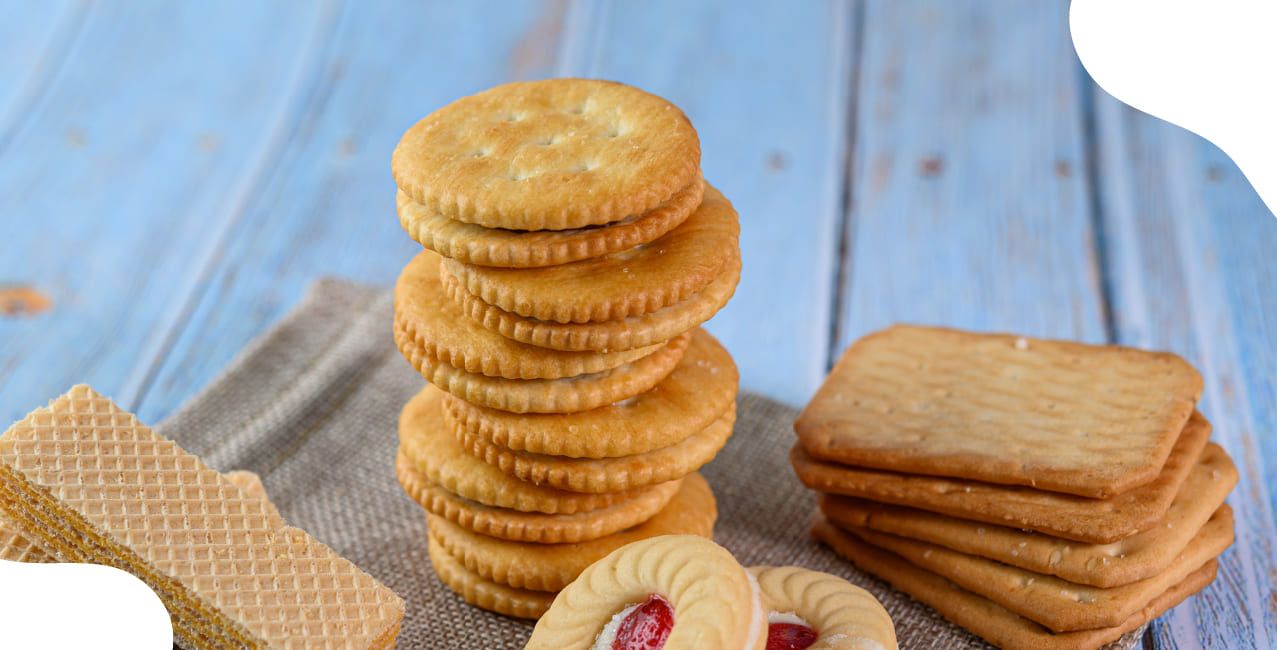
Author
LoansJagat Team
Read Time
5 Min
25 Sep 2025
GST on Biscuits – Updated Tax Rate & Guide
Key Highlights
- GST on biscuits before 22nd September,2025, will be 18% while after the date, it will be 5%. This was announced on 3rd September, 2025.
- HSN codes for biscuits are 1905. For different biscuits, further digits are added. This makes taxation for different TYPES of biscuits easier.
- Manufacturers can claim ITC on inputs. Small retailers under composition or selling loose biscuits often cannot.
The Indian government has simplified tax slabs to 5% for essential goods and 18% for regular goods. An additional 40% is introduced for luxury or “sin” items. GST on Biscuits now fall into 5% tax slab, irrespective of whether they are chocolate biscuits or plain ones.
For example, Priya buys ₹100 aata biscuits and Sunfeast Dark Fantasy Choco Fills for the same amount before and after 22nd September, 2025. The taxes will be as shown in the table given below
So, that’s a difference of ₹13 for every ₹100 purchase. The rules have been changed, and so should your understanding of GST on Biscuits. In this blog, we will discuss GST on biscuits, HSN codes, ITC on biscuits and more.
GST on Biscuits: Categories, Prices and Tax Rates
Under the new tax regime, the biscuits will be taxed at 5%. But the question arises, what kind of biscuits are we talking about? Cream biscuits, nut biscuits or the unbranded ones? Let’s clear the confusion with the help of the table given below.
Unbranded loose biscuits (e.g. small bakeries selling unpackaged biscuits) do not add GST. Retail prices include 5% GST on biscuits.
Read More - GST on Sugar – Tax Rate, HSN Code & Market Impact
HSN Codes for Biscuits
HSN stands for Harmonised System of Nomenclature. It is a globally accepted system developed by the World Customs Organisation (WCO). It was introduced to classify goods in a systematic and standardised manner. The following are the characteristics of HSN codes:
- Each product is given a unique HSN code (usually 6–8 digits).
- In India, HSN codes are used to classify goods so that the correct tax rate can be applied. It comes under the GST system.
- Since it is a global regime, it makes trade (domestic and international) easier.
For biscuits, HSN codes start with 1905. More digits are added after it, as per the biscuit types. The table given below shows different HSN codes for different kinds of biscuits.
The exact code can affect the rate/ITC. So, always verify the correct HSN on the GST portal or with a tax advisor.
For example, Himanshi lives in Jaipur and regularly buys biscuits from her neighbourhood shop. Last week, she purchased 2 kg of unbranded bakery biscuits from a local vendor at ₹200 per kg. The shopkeeper mistakenly billed them under HSN 1905 (sweet biscuits) with 5% GST, instead of treating them as unbranded/local biscuits (HSN 1905 90 20), which are exempt.
As a result, Himanshi ended up paying extra GST on biscuits of ₹20 on a ₹400 purchase that she didn’t actually need to pay. The table below summarises the example.
For small transactions, ₹20 may feel minor, but on a larger scale (like bakeries, distributors), wrong classification can mean lakhs in GST or missed ITC.
Do you know, due to the recent GST reform (Sep 3, 2025), GST on biscuits was reduced from 12-18% to 5%. Some analysts estimate that this relief could also help reduce inflation by 50–90 basis points (0.5-0.9 percentage points) over the next year.
Input Tax Credit (ITC) on Biscuits
Under GST, Input Tax Credit (ITC) was introduced to reduce the net tax liability for manufacturers. If a biscuit maker pays GST on raw materials like flour, sugar, oil, or even packaging, that amount can be claimed back against the GST they collect on biscuit sales. This prevents the tax-on-tax system.
Retailers, however, usually don’t get this benefit. If they are under the composition scheme (turnover under ₹1,50,00,000) or sell loose/unbranded biscuits (exempt), they can’t claim ITC. This is because no GST invoice exists for such supplies.
Also Read - GST on Atta – Why Your Daily Dough Now Costs a Bit More
For example, Himanshu owns a small bakery in Delhi that makes and sells premium cookies. He buys raw materials:
- Wheat flour worth ₹50,000 (5% GST = ₹2,500)
- Sugar worth ₹20,000 (5% GST = ₹1,000)
- Packaging cartons worth ₹10,000 (5% GST = ₹500)
Total GST on biscuits paid on inputs = ₹4,000
On selling his biscuits, he makes sales of ₹1,00,000, with GST at 5% = ₹5,000.
Output GST on biscuits collected = ₹5,000
By claiming ITC of ₹4,000, his net GST payable is ₹1,00 instead of ₹5,000.
Now, compare this to Rani, who runs a small kirana store. She buys branded biscuit cartons worth ₹10,000 (5% GST included). Since she’s under the composition scheme, she cannot claim ITC. She simply pays the purchase price and sells at a margin.
Let’s compare finances for Himanshua and Rani.
Manufacturers and big bakeries benefit significantly from ITC, while retailers under the composition scheme don’t. For manufacturers, the tax burden is relieved, and for retailers, the operations are less tax-efficient.
Latest GST Notification on Biscuits (Sept 2025)
As part of the GST rationalisation, the GST rate on biscuits has been reduced from 18% to 5%, effective 22 September 2025. These GST amendments fall under the ‘GST2.0’ regime. You might know, but manufacturers can change the MRPs of unsold stock to balance out the new rates.
Impact of GST Rate Cut on Biscuit Prices and Consumers
The essentials, like groceries, will become more affordable while the luxurious commodities have become more costly.
Conclusion
Earlier, biscuits were taxed at 18%, but after the new tax regime (GPT 2.0), GST on biscuits is 5%. These change was announced on 3rd September, 2025 and are applicable from 22nd September, 2025. Unbranded biscuits are exempt from taxes, so check the HSN code carefully. To reduce tax liability, ITC (Input Tax Credit) was introduced. The tax affects the manufacturers, retailers, and final consumers across the supply chain.
Frequently Asked Questions
What happens when biscuits are sold as part of a combo pack with other items
If biscuits are the main item, the GST rate applicable to biscuits applies to the whole pack as it is treated as a composite supply. If each item is invoiced separately it is taxed at its individual GST rate.
Is an e way bill required for transporting biscuits
Yes an e way bill is mandatory if the value of the consignment including biscuits exceeds fifty thousand rupees. Transporters and suppliers must generate the e way bill to ensure compliance with GST movement rules.
Can discounts given on biscuit sales reduce GST liability
Yes if the discount is shown on the invoice at the time of sale it reduces the taxable value. If the discount is given later the seller must issue a credit note to adjust GST liability accordingly.
How does selling biscuits through online marketplaces affect GST on biscuits?
Online platforms may charge and report GST on biscuits on behalf of sellers. Sellers must register for GST if turnover exceeds the threshold and should issue proper tax invoices following GST norms.
Does packaging (e.g., glass jar vs. carton) change the GST rate on biscuits?
Packaging can alter the HSN classification and hence may change the GST rate. Always confirm classification based on packaging type to ensure correct GST on biscuits.
What about imported biscuits? How are they taxed?
Imported biscuits attract customs duties plus IGST under GST. Both must be considered to calculate the total landed cost and compliance requirements.
How does shelf-life or composition (e.g., high fat/sugar) affect GST classification of biscuits?
Special formulations or nutritional properties may affect the HSN code and GST rate. It is advisable to seek expert classification advice for atypical products.
About the Author

LoansJagat Team
‘Simplify Finance for Everyone.’ This is the common goal of our team, as we try to explain any topic with relatable examples. From personal to business finance, managing EMIs to becoming debt-free, we do extensive research on each and every parameter, so you don’t have to. Scroll up and have a look at what 15+ years of experience in the BFSI sector looks like.

Quick Apply Loan
Subscribe Now


